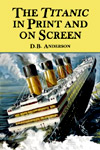 |
Anderson, D. Brian. The Titanic in Print and on Screen, An Annotated Guide to Books, Film, Television Shows and Other Media. 1st printing. Jefferson, NC: McFarland & Company. April, 2005. wraps. isbn: 0786417862. scarcity: fairly common.
Titanic in Print and Screen is not a bibliography in the truest sense of the word, it is more of a descriptive checklist. This format was probably chosen to be more user friendly to the average reader. What it lacks in bibliographical finesse it more than makes up for in breadth of coverage. It includes all types of media produced through the end of 2003.
In all there are twelve chapters covering nonfiction books, novels and short stories, children’s books, narrative films, television episodes, documentary films and videos, plays, selected essays and articles, poems and songs, comic books and parodies, multimedia software and selected web sites. There are also five appendices, and the work finishes with an index.
As with any anthology, some sections are more complete than others. Nonfiction books are competently, if not exhaustively, represented with 185 items. There are a respectable 59 entries for fiction and short stories; and a decent 86 children’s books. The book listings make up approximately two thirds of the text.
Book entries include author and title, publisher, year of publication and whether it is a hardcover of soft back. ISBN numbers are not included, which seems an odd omission. There is also a descriptive analysis of each title. These are of varying lengths from a sentence or two to a half a page or more. They are, for the most part, quite accurate.
Reprint editions are also noted, but this coverage is much more spotty. Many reprints are missing in action, even when they are important ones, like the latest edition of Patrick Stenson’s biography of Charles Lightoller. Sometimes the author uses the reprint edition as the main entry and lists the original under reprints. Other times a modern reprint is listed without the first printing being noted at all. Finally, although what to include and what to leave out had to be a thankless job, some critical titles like the original 1912 US Senate Inquiry and the British Board of Trade Enquiry reports are missing completely.
Titanic on film is very well covered, with sections on narrative films, television episodes and documentaries. The information on each film is impressive with a host of details from director and producer, to major cast members, even including music writers. As with the books, there are descriptions of each work, and also like the books, these are pretty spot-on.
The rest of the chapters, starting with plays, are significantly shorter, mostly a couple of pages for each. There are five appendices of varying usefulness including the mostly pointless one on actors who have appeared in more than one Titanic film, and on the other hand, the very interesting appendix of non-Titanic related books written by passengers.
No book yet published is entirely error free, and there are a few bloopers in this one as well. But they really are rather scarce. The entire work is laid out in a very orderly, logical fashion, making referencing very simple. This is one of those titles you will want to keep close to hand, as you will find yourself dipping into it again and again to get the answer to a quick question. It is a pleasure to work with.
Publisher’s Description:
Titanic scholars contend that the demise of “the unsinkable ship” left more behind than a memory of April 15, 1912, as an important point in history. Through books, films, stories and songs, the archetypal shipwreck has endured as a metaphor for the perils of mankind’s hubris and the fallibility of technology. In 1985, the discovery of the long-missing wreckage two miles below the surface of the Atlantic revitalized interest in the Titanic and spawned a new generation of books, films, and, for the first time, websites and computer games. James Cameron’s blockbuster Titanic became the biggest movie of all time and engendered still greater popular interest in the tragic event.
This bibliography is a survey of the immense volume of literary, dramatic and commercial endeavors that came out of history’s most compelling shipwreck. Organized by genre in accessible categories and short entries, the book includes Titanic-inspired documentaries, narrative films, children’s books, histories, short stories, novels, plays, articles, essays, software, websites, poems and songs. Each entry includes a brief review, bibliographic information, and the technical details of the specific source. The reviews include subjective analysis designed to reflect the usefulness of the source and to be of benefit to researchers and scholars. Seven useful appendices include lists of the actors in Titanic films, brief film and television appearances of the Titanic, comic books and parodies, films never or not yet released, books that survived the wreck, and books written by passengers.
|